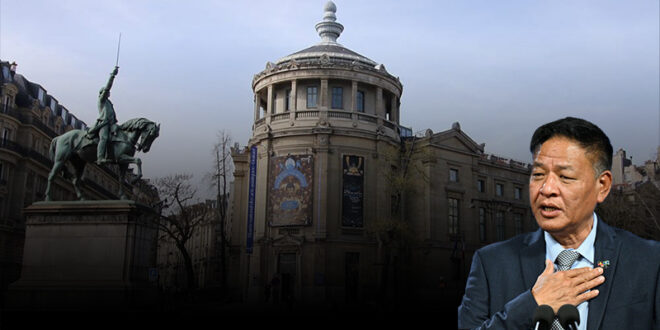Dharamshala: On 14 September 2024, Sikyong of the Central Tibetan Administration wrote a letter expressing deep concern and disappointment in two museums in Paris, acquiescing to the disinformation campaign of the Chinese government by replacing Tibet with Xizang in their catalogue of Tibetan artefacts.
The letter, sent via the Representative of Bureau du Tibet in Belgium, was addressed to several influential figures, including the French Minister of Culture, the Minister of Foreign Affairs, and the mayors of Paris, as well as the directors of the two museums and members of the Tibetan Support Group in the French Senate.
The letter reads, “I am writing to express my deep concern and disappointment upon learning that two reputed museums in Paris, the Musée du quai Branly and the Musée Guimet, have used “Xizang” or “Himalayan World”, respectively, in place of “Tibet”, which is widely used in French, in their collections of Tibetan artefacts as part of France-China cultural exchange programme. Such action of pandering to the wishes of the People’s Republic of China (PRC) government is deeply regrettable and that needs course correction.” Sikyong further asserted that this terminology shift was initiated by the United Front Work Department in 2023 and aimed at erasing the concept of Tibet as an independent cultural entity.
“The assertion that ‘Tibet’ should not refer to all areas inhabited by Tibetans is unfounded rhetoric,” Sikyong wrote, emphasising the historical context of the term “Tibet,” which encompasses the three traditional provinces populated by Tibetans. Sikyong emphasised that the term “Xizang” not only distorts the history of Tibet as an independent nation but also aids the Chinese government’s ongoing efforts to suppress Tibetan identity.
To highlight a stark contrast between France’s commitment to liberty and the actions of the aforementioned two museums, Sikyong added, “It is particularly disheartening that the said cultural institutions in France—a nation that cherishes liberty, equality, and fraternity—are acting in complicity with the PRC government in its design to erase the identity of Tibet. This utter disregard for linguistic norms and aspirations of the people of Tibet sets a dangerous precedent for democratic nations worldwide.”
In his closing remarks before concluding the letter, Sikyong implored, “In light of these circumstances, I strongly urge the two museums to reconsider their position and make accurate representations of Tibet in conformity with historical facts, international laws, and the aspirations of the Tibetan people.”
An annexure providing a concise historical overview was also included with the letter, as below.
*The Tibetan people refer to their land as “Bod” (བོད་) and call themselves “Bodpa” (བོད་པ) or “Bodmi” (བོད་མི). This term has evolved across various languages and cultures. The name Tibet originated from “Bhota” in Sanskrit and “Bhotta” in Pali in ancient India and later called “Tubbat” in Arabic; “Tibat” in Persian; and “Tabhod” (大蕃) or “Tufan” (吐蕃) in Chinese during the Tang dynasty. Marco Polo referred to it as “Tebet” in the 13th century, and by the 17th century, “Tibet” became widely used in English.
“Xizang” and “Wusizang” appeared in Ming Dynasty (1368-1644) documents and maps, initially referring to Tibetan areas and areas west of Dartsedo (Kangding). Scholars say that, as was the custom of naming dynasties in China, the term “Xizang” (西藏) was used in reference to the area ruled by the Tsangpa kings who controlled most of Tibet at that time. Thus, “Xi” means west, indicating the direction from the Ming Empire, and “Zang” refers to the Tsangpa kings. Even in the Manchu Qing era (1644-1911), Tibet was initially called “Tanggute” and “Tubaite”, derived from “Bod”. However, after the Seventh Dalai Lama (1708-1757), as the Manchu and Kuomintang governments exercised some level of control over Kham and Amdo, they created different terms for these occupied areas. The term “Xizang” (西藏) then came to denote only the regions ruled by the Gaden Phodrang government, (run by successive Dalai Lamas) with its territorial scope fluctuating over time.
Beginning 1949 and ultimate forceful occupation of Tibet by Chinese communist forces in October 1950, Tibet-inhabited regions were divided among four Chinese provinces before the establishment of the Tibet Autonomous Region (TAR) in 1965. Unlike Xinjiang, Inner Mongolia, Ningxia, Guangxi, and other autonomous regions where the name of the main ethnic group is included in the region’s title, Tibet was not called the “Xizang Tibetan Autonomous Region”.
Inconsistencies persist in the PRC government’s nomenclature, as it continues to use “Zangren” (藏人) and “Zangzu” (藏族) in Chinese and “Tibetan” in English when referring to Tibetan people. This inconsistency is evident in naming ten Tibetan autonomous prefectures and two Tibetan autonomous counties in Tibetan areas outside the TAR, the PRC government still use “Tibetan” rather than “Zangzu” in their official English titles.
Under the PRC government’s overarching strategy of “forging a strong sense of community for the Chinese nation”, over a million Tibetan children are forced into state-run colonial boarding schools, Sinicisation of Tibetan Buddhism through control over monastery administration and religious education, and forced relocation of Tibetan nomads and confiscation of their land under the guise of creating nature reserves and public parks.
These actions have consistently drawn grave concern from the US State Department, the European Union, United Nations human rights bodies, independent research institutes, and numerous human rights organisations.
On July 12, 2024, the US government enacted the Sino-Tibetan Dispute Act. This legislation explicitly states that China’s claim of Tibet being an integral part of China since ancient times is historically inaccurate. (https://www.congress.gov/bill/118th-congress/senate-bill/138/text). It clarifies that Tibet refers not only to the TAR but includes all three traditional provinces (Cholkha Sum). Moreover, it clearly pointed out that the Chinese government’s systematic suppression of Tibetans’ ability to preserve their religion, culture, language, history, way of life, and environment.




